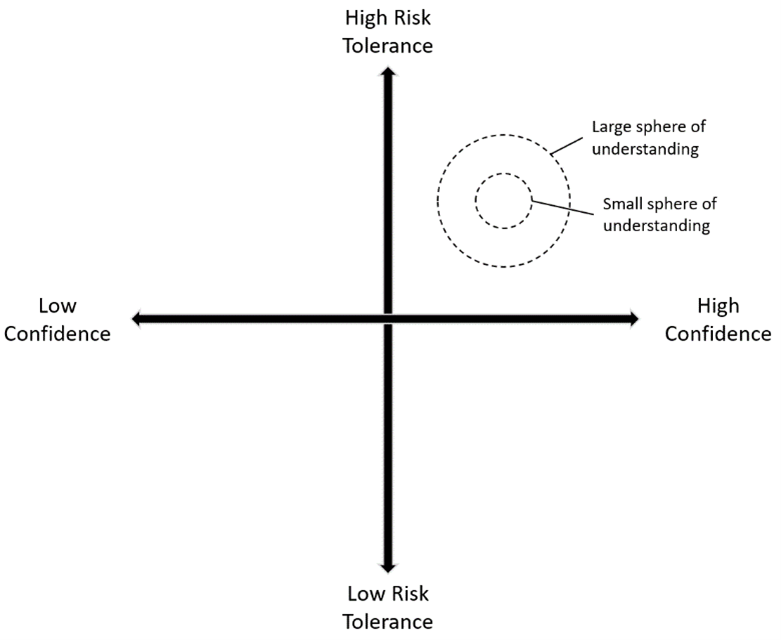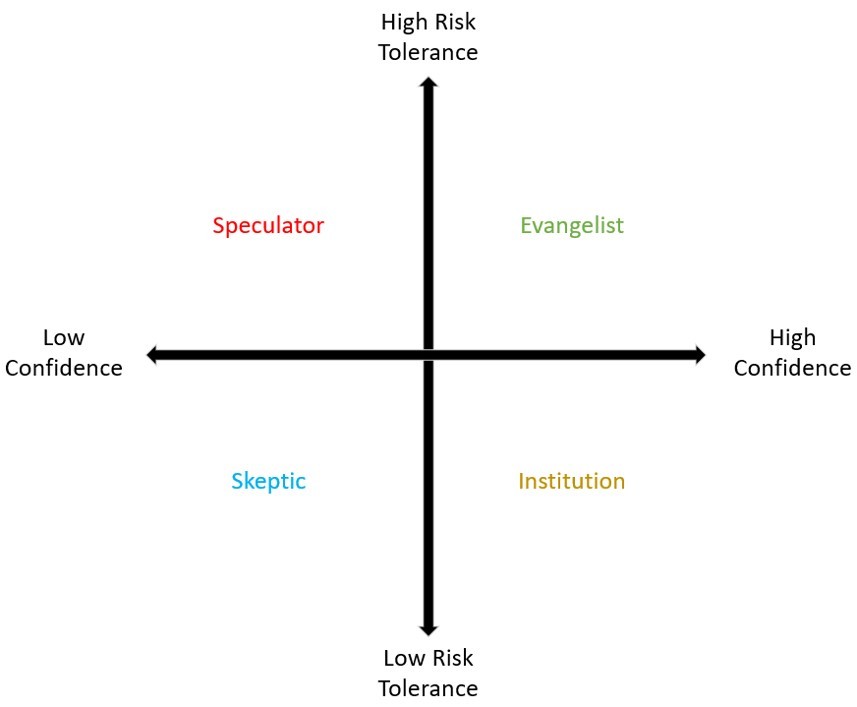Cryptocurrency. The word conjures a different perspective on this technology for each of us. In this article, I wanted to lay out a simple framework for how many of us think about investing in this asset class, to better reflect on the different perspectives out there. Most Australians have yet to invest in crypto, but the trend is quickly changing. As of September 2021, 1 in 6 Australians have invested in crypto [1] with a further 13% planning to do so over the next 12 months.
Below is the quadrant I’ve developed (the ex-consultant in me can’t help it!). I call it the ‘Investor CRU Quadrant’ – it stands for Confidence, Risk and Understanding. The intention of this framework is to help investors, be it in cryptocurrency or other sectors, better reflect on their own level of understanding, risk tolerance and levels of confidence with respect to an investment decision.
Defining the Dimensions
Confidence
Those with a high level of confidence hold a stronger sense of certainty in how their investment will perform. Someone with low confidence would have little certainty as to how they expect their investment will perform. They view the performance of their chosen selection as closer to randomness or luck if it goes well.

Risk
In financial investments, risk is defined as volatility (the standard deviation of an investment from its mean price over time). I would add that in conjunction with volatility, risk should also factor in the proportion of an investor’s portfolio. For example, buying a volatile cryptocurrency, but only willing to risk 0.0001% of one’s portfolio is hardly risk tolerant. However, being willing to invest more than 10% of one’s portfolio in a volatile asset is typical of someone with high risk tolerance.
Understanding
Those with a high level of understanding have typically spent more time reading, researching, and antagonizing their own point of view. Individuals with a high-level of understanding can explain a concept to varying degrees of detail, knowing both the advantages and disadvantages of their investment within the broader market in which it operates. Individuals with a smaller sphere of understanding may often avoid investing all together or invest because someone they follow has invested. They lack an ability to explain the fundamentals of their investment as well as the advantages and disadvantages with respect to alternative investments.
Important Considerations
Before delving into each of the quadrants, I’d like to note a few points:
1. High confidence does equate to a large sphere of understanding. Though, it is natural that a higher degree of understanding can often lead to a greater sense of confidence, a false understanding can also lead to high degree of misplaced confidence.
2. A large sphere of understanding does not mean one’s perspective is ‘right’ or that an investment will perform as expected. Moreover, there is no correct quadrant to be in as it changes from person to person, and importantly from one investment to the next for the same person.
3. This model should be interpreted as more of a spectrum than a clearly defined line in the sand with 4 distinct boxes. The naming of quadrants is more like the extreme stereotype of each combined axis and is simplified for ease of memorization.
4. Any investor or investment made on the very extreme end of two axes without a large sphere of understanding should question their assumptions and those of others closely. Extremes of risk tolerance and levels of confidence are often misplaced as markets do not behave in an absolutely rational manner.

Defining the Quadrants
Evangelist
Example: Michael Saylor, CEO of MicroStrategy and proponent of bitcoin.
As the name would indicate, an evangelist is someone that exhibits a high degree of confidence and risk tolerance towards an investment. This is often demonstrated through substantial investments as a proportion of their portfolio (typically well in excess of 10%). Other traits include a high degree of confidence in how they expect the investment to perform in the future. It is worth noting that while many experts typically operate this quadrant, so too do charlatans and confidence-men. When seeking a reputable source of information or financial advice, be sure to detect if the investor has a large sphere of understanding and to do that, often means critically analysing the information for oneself.
Institution
Example: Fidelity Investments
Institutions, particularly large and publicly listed ones are accountable to shareholders and executive committees. As part of this, there are strict criteria when it comes to managing the treasury and investment portfolio. A specialized team of analysts is dedicated to building confidence around the facts through in-depth research. Once a conclusion is reached, institutions make investments but are very careful to protect their downside risk and rarely go all-in on a ‘make it or break’ investment. Fund managers and diligent retail investors also fall into this category. They hold strong opinions as to how they expect an investment to perform yet also minimize their risk exposure through position sizing. It is possible to have institutions fall into other quadrants, though it is less common.
Skeptic
Example: Retiree
Skeptics can be anyone and everyone in respect to a particular investment. An easy example might be a retiree (though not all retirees) that expects to live for another two decades and has the funds to see them through a comfortable retirement. This type of person may express low willingness and apathy towards investing as well as minimal willingness to take on any financial risk. This category of investor is generally the opposite to an evangelist, expressing low confidence and low willingness to tolerate risk on a particular investment.
Speculator
Example: Dogecoin speculators and ICO pump and dump investors
Speculators often demonstrate a high aptitude for risk taking to have the chance of making large profits in relatively short periods of time. This can be seen in much of the crypto markets, predominantly outside of the well-established cryptocurrencies like bitcoin and Ether where the risk is substantially higher for a coin to go to zero, but also for it to increase 200X. While some speculators do express confidence and can fall closer to the center of the axis, the nature of obtaining outsized risks and reward for this investor group is largely dependent on volatility and risk.
Conclusion
Every one of us may fall into a certain category with respect to a different investment. It is important to understand where we fall in relation to investment that we choose so that we can avoid making high-risk speculative investments.
Perhaps, the one virtuous dimension is to develop that of a greater sphere understanding as possible. Acknowledging that while understanding can build confidence and hopefully better investment returns, that ultimately nothing is guaranteed in the world of financial markets. As Noble prize winner Richard Thaler points out, markets do not run with perfect efficiency and price transparency, and nor do all actors behave in a rational manner.
.png)
.png)